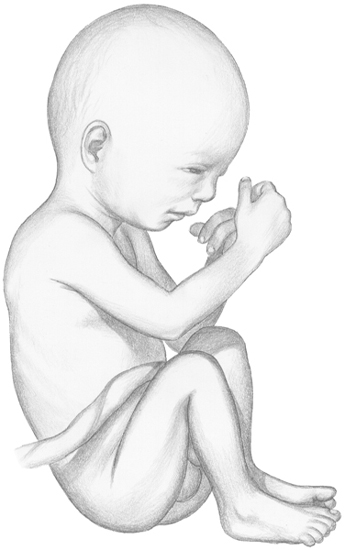1. How Big Is Your Baby?
This week marks the beginning of the
third trimester. Now we’ll be adding total length of baby’s body from
head to toe. This will give you a better idea of how big your baby is
during this last part of your pregnancy.
Your baby now weighs a little more than 2
pounds (875g), and crown-to-rump length is about 9? inches (24cm) by
this week. Total length is about 14? inches (36cm).
2. How Big Are You?
Your uterus is about 2¾ inches
(7cm) above your bellybutton. Measured from the pubic symphysis, it is
more than 10½ inches (27cm) to the top of the uterus.
3. How Your Baby Is Growing and Developing
The retina, the part of the eye where
light images come into focus at the back of the eye, is beginning to be
sensitive to light. It develops layers around this time that receive
light and light information, and transmits them to the brain for
interpretation—what we know as “sight.” From here on, baby will
probably be able to sense bright light. If you shine a light close to
your tummy, baby may react as it senses the change in luminosity.

Around this time, your baby’s eyelids open.
Your baby begins opening and closing its eyes
while still inside your uterus.
A congenital cataract is an eye problem present at birth. Most people believe cataracts occur only in old age, but they can appear in a newborn baby!
Instead of being transparent or clear,
the lens that focuses light onto the back of the eye is opaque or
cloudy. This problem is usually inherited. However, it has been found
in children born to mothers who had German measles (rubella) around the
6th or 7th week of pregnancy.
Another congenital eye problem is microphthalmia,
in which the overall size of the eye is too small. The eyeball may be
only two-thirds its normal size. It often occurs with other eye
abnormalities. It is usually the result of infections in the mom-to-be,
such as cytomegalovirus (CMV) or toxoplasmosis, while baby is
developing.
Feeling Baby Move
Feeling your baby move (quickening) is
one of the more precious parts of pregnancy and can be the beginning of
your bonding with baby. Many women feel they begin to connect with baby
and its personality by feeling its movements. Your partner can
experience and enjoy baby’s movements by feeling your tummy when baby
is active.
Movement can vary in intensity. It can
range from a faint flutter, sometimes described as a feeling of a
butterfly or a gas bubble in early pregnancy, to brisk motions or even
painful kicks and pressure as baby gets larger.
Some good news about baby’s movements. Studies show if your baby is active in the womb, he or she may be healthier.
Women often ask how often a baby should
move. They want to know if they should be concerned if the baby moves
too much or doesn’t move enough. This is hard to answer because your
sensation can be different from that of someone else. Each baby’s
movement can be different. However, studies show an active baby moves
at least 10 times in 2 hours. It’s usually more reassuring to have a
baby move frequently. But it isn’t unusual for a baby to have quiet
times when there is not as much activity.
If you’ve been on
the go, you may not have noticed baby move because you’ve been active
and busy. It may help to lie on your side to see how much baby is
moving. Many women report baby is more active at night, making it hard
to sleep.
Dad Tip
Offer to do various jobs around the house that may be more difficult for your partner now.
Cleaning the bathtub or the toilet can
be a big help. Carry the laundry up and down stairs. Unload the
dishwasher so you can put away heavy or awkward pieces. Add to her
safety by putting away anything that belongs in a high or
difficult-to-reach location.
If your baby is quiet and not as active
as what seems normal or what you expected, discuss it with your
healthcare provider. You can always go to the office to hear baby’s
heartbeat if it hasn’t been moving in its usual pattern. In most
instances, there is nothing to worry about.
Kick Count.
As baby gets bigger, kicks get stronger. Toward the end of pregnancy,
you may be asked to record how often you feel baby move. This test is
done at home and is called a kick count. It provides reassurance about baby’s well-being; this information is similar to that learned by a nonstress test .
Your healthcare provider may use
one of two common methods. The first is to count how many times the
baby moves in an hour. The other is to note how long it takes for baby
to move 10 times. Usually you can choose when you want to do the test.
After eating a meal is a good time because baby is often more active
then.